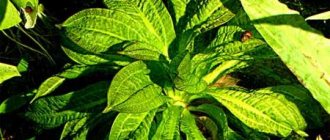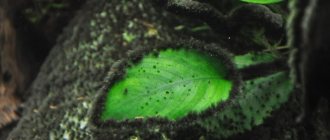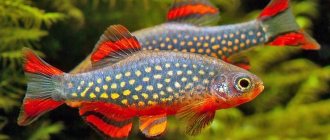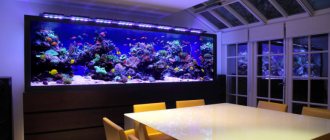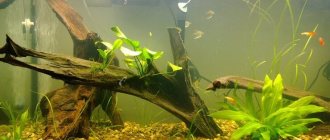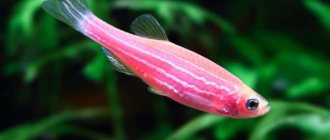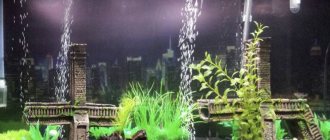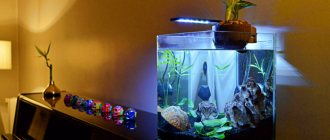Decorating an artificial underwater world is not an easy task, but the Thai fern will help you complete this job easily and efficiently, quickly filling the container with greenery. It can be planted in groups, in the form of a single spectacular bush, realizing any fantasies for decorating your home aquarium.
Aquarium ferns
A comfortable living environment is important to all living things on earth.
It improves development, growth, and well-being, so even in aquariums, vegetation must be present. Nowadays, many varieties of plants have been sufficiently studied and are in demand, but the most significant are ferns. The fern is famous for its regular reproduction, as well as its attractive appearance, so any aquarium with its presence looks like a real botanical garden, only inside a home pond.
Such a plant will never interfere with either other vegetation or the fish themselves. At the same time, waterfowl can freely hide under its foliage and swim freely, so the fern vegetation looks good and does not create inconvenience for pets living in the neighborhood. It is planted both in the central part of the aquarium and along the outskirts. In addition, fern is a good source of oxygen release.
Use as decoration
The Thai fern is an excellent decoration for the underwater kingdom. The home aquarium is significantly transformed, the plant fills the container with its bright bushes. The Thai fern allows you to create a variety of compositions from stones and underwater objects, forming green gardens in a short time. It literally brings the aquarium to life, perfectly complementing the underwater driftwood or fish house.
Small species of fish can spawn on its foliage and stems. Viviparous individuals can calmly retire in the thickets of the plant, and weak ones can hide from aggressive neighbors. The fern creates a cozy, peaceful environment, improves the area, and does not require special care.
Aquarium ferns: types
To decorate a home pond, modern aquarists prefer tropical ferns. This is due to its beautiful appearance and resistance to high moisture.
Indian water fern
Indian water fern
It was first discovered in Asia. Today it can be observed in many countries: South America, Australia, Africa. When this fern is young, it is not planted in the ground. It is freely located on the water surface and lives there until several additional leaves appear on it.
Indian wing fern (water cabbage)
Watch a video about Indian fern:
Thailand fern
From the name of the Thai fern alone, it is clear that its origin came from Thailand. This variety of fern plant is distinguished from the previous species by the presence of many legs. Its daughter leaves develop on a single creeping root system, but are separately living algae.
Horn fern is found in Madagascar and in humid areas of Africa. Its peculiarity is its unusually beautiful leaf shape, similar to a wide feather.
Video about Thai fern:
Shield fern or Bolbitis fern
Bolbitis fern on driftwood
This is a unique plant and the only one with these characteristics: it differs from its counterparts in the stem, which does not have a vertical position, but is located on the aquarium substrate. Also on its petioles and stems there are waxy scales of golden color.
In addition to these varieties, there are many less popular fern options, for example:
Marsilia fern in an aquarium
However, from the description it is impossible to determine which one is more suitable for your own aquarium. In this case, it is recommended to observe these algae living in the store aquarium space.
After acquiring such vegetation, you will definitely need to create comfortable living conditions for it.
Fern care
Content Features
Fern plants have captivated many aquascapers with their unpretentiousness. Unlike many fish and plants, they are less demanding of water purity, so they feel much better in reclaimed water than in new water. To breed algae of this variety, you should change the aquarium liquid as rarely as possible. In this case, you should not make a 50% substitution, ¼ is enough.
Water requirements and feeding
However, the plant makes demands on the water parameters of the aquarium space itself. For good fern development, the necessary water is soft, slightly acidic or neutral. If the aquarist has a desire or need to increase the growth of the fern, then he should add urea fertilizer (it is freely available in a specialized store). Maintaining the aquarium temperature should be +20-24℃, which is quite consistent with the parameters required by most fish.
Lighting
Ferns are light-loving plants, so lighting a home pond will allow them to grow and develop well. Of course, if they live in a shaded space, they will not die, but if they stay in an uncomfortable environment for a long time, the plant will begin to wither and get sick. It is recommended to provide them with at least 12 hours of daylight, even in winter. To do this, you can install a fluorescent lamp near the aquarium space.
Fixation in the soil
Rooting a fern will not be difficult even for a novice aquarist. The plant is not demanding on the substrate, so replacing it before planting the plant is not required. However, it is recommended to place pebbles there (if the soil is sandy). They are required so that the fern can gain a foothold in the ground soil for the first period of time, and then the vegetation adapts and adapts to the new habitat.
Cohabitation
Plants of the fern variety get along well with calm, peaceful fish that hide behind their leaves and do not damage them. Regarding other algae, it is better to avoid planting together to avoid intertwining of leaves.
A special feature of ferns is the cleansing of the aquarium space from harmful components that affect other aquatic inhabitants.
However, such an exotic plant can also absorb useful substances, but this is less dangerous for the fish around it.
No fern diseases were detected. The only cause of the disease can be improper care. You should be careful with feeding; its excess can affect the plant not only for the better, but also for the worse.
Reproduction, general data
Fern plants reproduce vegetatively, and they can independently separate daughter leaves that will float on the surface of the water. They will remain there until small roots appear on them, after which the young ferns will sink to the bottom and cling to the ground. It is recommended to notice the appearance of the root system before they take root in the substrate, then you should move them to another habitat.
Reproduction and growth
If comfortable conditions are created for the vegetation, then the spore fern will reproduce day and night. The stem height of vegetation can reach 60 cm inside a home pond. If a fern plant grows excessively, it will need to be dismembered and disposed of from the general aquarium. To do this, you can use various points of sale, give it as a gift to relatives (friends) for a holiday, or transplant it into another aquarium.
Despite the unpretentiousness of the fern variety, you should not interfere with its natural development. This can cause unpleasant consequences.
It is strongly recommended that you replant and relocate this plant as little as possible.
When planting plants from the fern family in your own home pond, it is advisable not to disturb its dormancy, and be careful with intensive filtration, fishing, and water purging so as not to disturb their dormancy. Also, this plant is absolutely not suitable for fish that burrow into mud (for example, aquatic inhabitants of the carp family), because they are able to dig up the plant.
Care and maintenance
In order for the Thai fern to truly become a decoration in the aquarium, it is necessary to follow the recommendations for maintenance and care. Otherwise, the normal development and growth of the ornamental plant will be suspended.
Recommendations for care, or what to pay attention to:
- Chemical composition of the aquatic environment. It is necessary to monitor the acidity and hardness of water. The most attractive values for the comfortable existence of the Thai fern are: hardness no more than 6°dH and acidity in the range of 6-8 pH. It is believed that “old” water that has been left alone for some time has these characteristics. Experienced aquarists do not recommend replacing the water completely when cleaning an aquarium - it is enough to change 20% of the liquid once a week.
Important! Increased levels of water hardness and acidity slow down the growth and stop the process of algae reproduction. It is also possible that black spots may appear on the leaves.
- Temperature conditions in the aquarium. Cool water has a bad effect on the development of algae leaves and root systems. It is believed that the wing fern can exist at temperatures from +18 to +28°. In this case, it is necessary to make a footnote that it is recommended to maintain a constant temperature in the range of 22–24°.
- High quality lighting. A daylight period of at least 12 hours is necessary for the proper development of the roots and leaves of the Thai fern.
Important! Powerful lamps can harm Java fern. The use of such lighting sources has a bad effect on the juiciness and brightness of the leaves.
- Priming. The presence of soil is not a prerequisite for keeping Thai fern. The root system of the plant is underdeveloped. This type of fern lives well in an aquarium, at the bottom of which there is a layer of silt. To secure a plant in one place, just tie it to a piece of driftwood or a clay pot, for example, with fishing line. As a rule, the Java fern eventually finds a place to take root, but most of the roots remain free and feed on nutrients from the water.
- During the active growth of the fern, its rhizomes require additional care. Experts recommend adding fertilizers and microelements to the water once or twice a month, thereby promoting more active and healthy growth of the entire plant.
Interesting: Urea is used as a special fertilizer for the root system. This substance is believed to accelerate the growth rate of ferns.
- Availability of a water filtration and purification system. Ornamental plants, as a rule, are not planted next to filters and other devices, since operating devices can damage the leaves and stems of the fern.
- Neighborhood of bottom fish and Java fern. Fish belonging to the bottom phenotype (known representatives are catfish and agamixis), exploring the soil, dig it up. Since the roots of the Thai fern are partially in the ground, fish can harm them through their actions. Angelfish, guppies, and swordtails are considered good neighbors for the Thai fern.
Thailand fern in your aquarium
Important! When planting new plants in an aquarium, remember that the distance between two specimens should be at least 10 cm.
Thailand fern - growing and decorating an aquarium
Decorating an artificial underwater world is not an easy task, but the Thai fern will help you complete this job easily and efficiently, quickly filling the container with greenery. It can be planted in groups, in the form of a single spectacular bush, realizing any fantasies for decorating your home aquarium.
Diseases and pests
Pests of the Thai fern are bottom-dwelling fish that like to dig up the soil. It is advisable to systematically carefully remove areas damaged by them to allow new growth of the aquatic plant.
Bottom fish
It is undesirable for the fern to live next to the following types of fish: corydoras mutaea, catfish, agamixis. Ideal for: guppies, anubias, apistograms, angelfish, swordtails.
Improper care can harm a fern: lighting will burn the leaves and affect their color; hard and acidic water will completely destroy the foliage and stop the process of reproduction and growth.
For your information. In order to prevent diseases, you should take proper care of the plant.
Thailand fern - description
Wild species of this plant inhabit the coastal areas of the countries of Southeast Asia, growing up to a respectable 50 cm. In captivity, Thai ferns are aquarium plants with moderate sizes up to 25-30 cm, growing slowly under the artificial sun throughout the year. Microsorum pteropus settle on stones, covered with silt, and large snags, attaching to supports using rhizoids in the form of thin thread-like formations. On the leaves of aquatic ferns, spores are clearly visible, darkening as they ripen.
Thailand fern - species
The popular Thai aquarium fern, popular among hobbyists, has several varieties. Some plants appeared naturally, others were bred by skilled experimenters who cared about the emergence of new varieties of underwater flora for artificial home reservoirs. The most widespread are two newcomers from Southeast Asia, significantly different in shape and size of bright leaves - the Thai angustifolia fern and the Thai winged fern.
Thai angustifolia fern
The main difference between these ferns in the aquarium and the classic pterygoid species is the presence of elongated and narrow leaves. With good care, Microsorum pteropus “Narrow Leaf” reaches 20 cm, but if the conditions are not suitable for it, the plant does not grow more than 10 cm. Thickets of narrow-leaved fern look like dense forests in which it is convenient for fish to spawn. Its growth rate is small, approximately 1 leaf appears per month. Hobbyists always note that this dark green form always looks gorgeous when combined with light-colored aquatic plants.
There is an original variety of this plant, artificially bred by specialists from Tropica Aquarium Plants, highly appreciated by aquarists all over the world - the Thai Vindelova fern. It has a decorative appearance due to the unusual carved tips on the leaves, which make the green rosette much richer. Microsorum pteropus “Windelov” is smaller in size than a simple fern, growing 15 cm in height, so it is often planted in the center of the container or closer to the front wall.
Decorating a small aquarium with ferns
The water landscape in a home aquarium requires a special approach and imagination from its creator. You can buy decorative fish and an expensive tank, equip the container with the necessary equipment, but if it is poorly designed, all your efforts will be in vain, and your aquatic world will look poor and unkempt. The Thai fern helps to construct any composition from decorative objects and stones in a short time, turning even small tanks into green gardens.
This ornamental plant forms an elegant rosette of leaves, but overall it takes up little space inside. The presence of the beautiful Microsorum pteropus instantly enlivens an artificial ridge of stones or a lonely snag. A water fern for an aquarium is great for creating an underwater alley. A frame of the required shape and size is constructed, and the prepared rhizomes of the seedlings are attached to it with fishing line or other material. After a couple of months, you get a decorative hedge of bright green leaves.
Thailand fern - contents
This aquatic plant does not cause significant trouble for its owners, but if basic care rules are not followed, it can significantly slow down the development of the root system and leaves, which will affect its decorative effect. Thai ferns like to be kept quietly in the aquarium, when mechanical influences are rarely applied to them. Microsorum pteropus does not tolerate intensive water blowing and proximity to voracious active fish that constantly turn over the soil in search of food.
Differences between ferns and mosses
What are the differences between ferns and mosses? What are the main characteristics that separate them?
- Mosses cannot reproduce without water.
- Compared to mosses, ferns photosynthesize very quickly. But mosses can photosynthesize even under snow cover.
- Mosses have very small leaves; ferns have larger ones.
- Interestingly, individual mosses can specifically swamp their habitat.
But there are similarities between mosses and ferns:
- They love moisture.
- They existed many millions of years ago.
- These are the highest forms of spore plants.
Sorry, there are no surveys available at this time.
Fern in an aquarium - care
There are several criteria that greatly influence the successful growth and development of this underwater organism - environmental temperature, its chemical indicators, soil quality, lighting. Thai fern in an aquarium can be kept at home by beginners who have recently begun to master the art of keeping exotic fish, but to successfully complete this task they need to learn the basic rules for caring for the amazing plant Microsorum pteropus.
The main conditions for good growth and reproduction of the Thai fern:
- Chemical composition of water. The liquid should be used with a hardness level within 6dH and an acidity level of 5.5-7 pH. In many cases, old aquarium water has similar characteristics; for this reason, the medium should not be changed frequently. A partial replacement of 20% of the liquid in the container every 14 days is enough.
- Water temperature. Thailand fern does not tolerate cool water well. A decrease in temperature to 18°C stops the growth of leaves and roots, so the best conditions for Microsorum pteropus are considered to be an aquatic environment at 24°C.
- Lighting quality. If you want to get a powerful plant with bright exotic leaves in your aquarium, then it is advisable to maintain 12 hours of daylight for it.
Plant propagation
Vegetative methods are used for propagation:
- Bushes of most large ferns grow slowly. During vegetative propagation, part of the large rhizomes is separated, choosing a branch with several well-developed leaves and roots.
- Floating varieties take root easily by breaking off pieces of the leaf.
- Small ferns (anubias, marsilia) must be dug up in the form of a fragment of a dense carpet to be transferred to another container. It is carefully disassembled with tweezers into groups, which should contain 4-5 well-developed leaves. Most often, they are all connected by a thread-like stem. The delenki are transferred to a new place and pressed to the ground.
Azolla, salvinia and other floating species can reproduce by spores. Before the dormant period, the vegetation dies off, and the spores overwinter at the bottom of the reservoir. At home, they can be preserved if they are not removed when cleaning the sand, so aquarists do not use this method.
Bookmarks 0
How to plant fern in an aquarium?
You don’t need to study thick books and leaf through a lot of information to learn how to plant a fern in an aquarium. It develops well on any soil without the supply of carbon dioxide, being artificially attached to a heavy object - a stone, a massive snag. The slow growth of Microsorum pteropus is a big plus for the aquarist; hobbyists do not have to deal with frequent pruning of plantings and removal of excess shoots.
How to secure a Thai fern?
When it comes to planting Thai fern, you can use different methods. All of them are quite good and easy to use, both by amateurs and professional aquarists. Here is a list of tools that will help you decorate an aquarium without unnecessary hassle at home:
- Fastening with fishing line.
- Tying the fern to snags or stones with nylon thread.
- Use of rubber bands. This type of fastening is reliable, but does not look aesthetically pleasing in the aquarium.
- Often, amateurs use high-quality waterproof superglue of the “Moment” type to solve the problem. It is necessary not to lubricate the sheet completely, but to apply a few drops in the required place. At the point of contact, the roots will die, but by this time the Thai fern will have grown and will be able to securely attach itself to the support.
How to fix it on a stone or driftwood?
This procedure can be carried out in various ways. All of them are quite practical and suitable for every person, since scrap materials that are found in every modern apartment are used to secure the plant.
Actually, you can attach the fern as follows:
Fishing line. It is in every house where a fisherman lives. But if not, then it can be purchased at any specialized store, and it is quite inexpensive. The advantage of fishing line is that it does not dissolve in water and looks invisible if you do not reel in too much. But when tying a bush, you need to be careful, since the fishing line can easily cut a leaf or stem. Accordingly, there is no need to tighten too much;
Thread. The ideal option is nylon, since this material resists water well and is generally very reliable. If it is not there, then ordinary cotton threads will do. But their disadvantage is that over time they can dissolve in water. Therefore, the fern should be wrapped well, “conscientiously.” Especially if the aquarium contains ancistrus and other similar fish that like to “explore” everything;
Wire . The best fit are those small scraps that are used to wrap new headphones and other wires (for example, when buying a computer, mouse, keyboard, etc.). They do not affect the water in any way and are very easy to use. Tying ferns with thread is very inconvenient if you do it right in the aquarium and not in the room. Wire wins significantly in this sense. We attach the bush to the branch, wrap it with a piece of wire and spirally twist it from behind, gradually tightening it so that the plant does not dangle;
Glue "Moment". It is important that it is of high quality and waterproof. Just a few drops on the roots and press them to the stone. They, of course, will die off, but by that time the Thai fern will have become stronger and will be able to cling on on its own.
Thailand fern - propagation
To successfully propagate this plant, hobbyists will need to divide the existing Microsorum pteropus plant into pieces, each of which will contain a couple of leaves and part of the rhizome. In the question of how to propagate Thai aquarium ferns, you can use the second method with the help of growth buds that appear on an old, almost destroyed leaf, where a new rhizome begins to develop. When the leaf completely dies, the young fern breaks away from the mother plant, rising upward. Then the roots develop, pulling it down to the soil.
Reproduction
The fern reproduces vegetatively. There are two methods:
- From one old plant you can get a number of new ones if you divide their rhizomes. The presence of foliage on any new seedling is considered an indispensable circumstance.
- Another method is typical for ferns. Small kidney-shaped processes appear on old leaves, which tear off the leaf and float to the surface of the water, thereby creating a new independent plant; in this case, the old leaf dies.
Thailand fern - diseases
The plant does not have a real rhizome; it receives all trace elements directly from the liquid. With a lack of nitrogen and other components, Microsorum pteropus growth slows down and problems arise. Often the leaves of the Thai fern turn black when the hardness of the environment increases, so amateurs need to periodically monitor the chemical composition of the liquid. Damage to the rhizome is caused by bottom fish digging up the soil; careful removal of areas of the plant damaged by them promotes the rapid growth of new leaves and roots.
Diseases
Thailand fern is an unpretentious plant. He has no diseases as such. Damage can be caused by improper actions taken by the aquarium owner to care for the fern. Therefore, strict adherence to recommendations for the quality of lighting, chemical composition of water and temperature conditions will keep the plant in excellent condition for a long time.
If you find wilted leaves, carefully cut them off using scissors. This action will allow new leaves and roots to grow.
Aquarium ferns and their care
Aquarium fern is one of the most common and beautiful plants that inhabit home decorative ponds. Fern vegetation is not only an excellent shelter for the inhabitants of aquariums, but also contributes to the constant release of oxygen into the water. Ferns are distinguished by their unpretentiousness, and if simple care rules are followed, they will delight the eye of both experienced aquarists and beginners for a long time.
Compatibility with aquarium inhabitants
Ferns get along well with small fish that swim and spawn in the leaves, which is important to consider when creating Dutch aquariums. Planting next to tall plants will cause problems due to their intertwining, and careless untangling will damage the stems and foliage.
Fish that are accustomed to digging should not be grown in the same tank with ferns, as their activity will affect the condition of the rhizomes. The consequences can be different, including the death of plants.
Ferns have the ability to absorb nutrients. This does not affect other inhabitants of the aquarium in any way.
Types of green inhabitants
Aquarium ferns belong to spore plants; under favorable conditions they are able to grow independently. Most of the fauna inhabiting aquariums are inhabitants of tropical latitudes. Such plants are accustomed to high humidity, so they feel very comfortable in captivity.
In nature, there are several species of this family that perfectly adapt to life in a home pond:
- Indian water fern (lace) - Asia is considered the birthplace of this species, but the plant is also common in the north of Australia, tropical Africa, and South America. Among lovers of the aquatic world, the lace fern is considered a very popular plant, the height of which varies from 40 to 50 cm. Young shoots of the crop are not planted in the ground, but are left to float on the surface of the water until the plant acquires several additional leaves;
- Thailand fern - grows mainly in Thailand. Unlike the Indian species, this plant is characterized by the presence of many legs. It has a creeping rhizome on which separate shoots (daughter) are formed. Single green lanceolate leaves of the plant extend vertically from the rhizome. In appearance, the leaves have a leathery structure, their surface is in small tubercles;
- Bolbitis or Shield Fern - the petioles and stems of this species are covered with waxy golden scales. Bolbitis differs from other varieties by the presence of a horizontal stem, which gives the plant a recumbent position;
- Wing fern - because of its large fleshy leaves, it is popularly called “water cabbage”. Belongs to the horn-shaped family. Habitat in nature - in Central and South America, in India (southern states). The plant is quite large, easily adapts to life in muddy water, and loves warmth. It grows both in moist soil and simply floating on the surface of the water;
- Aquatic Malayan fern - belongs to the Java fern family. The plant has finely dissected light green leaves, which can reach a height of about 40 cm. This species cannot be planted in the ground; the aquatic fern must be attached to any elements of the aquarium interior that have a hard surface (stones, grotto, driftwood, castles, etc. .).
Rules of care
It is not at all difficult to create comfortable conditions for the inhabitants of the flora in the aquarium, since the plants do not have any special maintenance requirements. Only the unpretentious hornwort in an aquarium can be compared in the ease of caring for ferns, which is also very popular among novice aquarists.
Aquarium water
Fern-like aquarium plants do not like to change the liquid too often. The most comfortable habitat for them is water, which has already been inhabited by aquarium inhabitants. Therefore, for better conditions for maintaining vegetation, old water in a decorative pond is partially replaced with fresh water (no more than 1/4 of the total volume of the vessel and no more than once in 14 days).
Water for plants must be neutral and soft; sometimes a slightly acidic composition of the liquid is allowed. If an aquarist wants to increase the number of ferns, it is necessary to purchase urea-based fertilizer from a specialized store. The water temperature should not fall below +20ᵒC and not exceed +24ᵒC, that is, just the most comfortable environment for the existence of the majority of the inhabitants of the aquarium.
Lighting requirements
All types of aquarium ferns are light-loving, so it is necessary to create the right lighting for the plants. In a darkened aquarium, the vegetation, of course, will not die, but it will not delight its owner and the inhabitants of the reservoir with its rich color and beauty. With insufficient lighting, ferns begin to fade, and some varieties even become sick. For better growth, green inhabitants of aquariums require daylight that lasts at least 12 hours, even in the winter. A fluorescent lamp located close to the walls of the vessel can maintain the necessary light conditions for an aquarium.
Beautiful video with a fern in an aquarium.
Landing in the ground
Fern vegetation is not picky about any type of soil, so it is not necessary to purchase a special substrate for green residents. A water fern can exist even in sandy soil, but for more comfortable growth and development of an aquarium plant, it must be secured with several pebbles. After a short amount of time, a representative of the green world will adapt and adapt to new living conditions. If there are other flora inhabitants in the decorative pond, it is better to plant the fern in the aquarium at a short distance from its neighbors, otherwise the plants tend to intertwine with each other.
Plant propagation
When an optimal environment is created in the aquarium, water ferns reproduce on their own; no special effort is required for the growth of vegetation. For example, in the Indian species, daughter shoots appear on old leaves, which, after the formation of several leaves, as well as roots collected in a bunch, are able to break away from the plant and float upward. Young shoots of aquarium ferns feel comfortable both in a floating state and when planted in a substrate.
Different types of fern vegetation differ slightly from each other in methods of propagation. For example, vegetation from Thailand produces new shoots differently, and the propagation process is as follows:
- You can carefully divide this type of one plant into small pieces, each of which will contain several leaves and roots. Next, small shoots are strengthened in the ground or left to float on top of the water.
- Thai fern is also grown in another way. Growth buds appear on the old leaf of the crop, from which new shoots with roots begin to develop. After the old leaf dies completely, the formed shoots are separated from the main plant, rising upward.
- After a short amount of time, the rhizomes of young shoots extend downward, and then attract the plant to the ground.
Aquatic ferns grow slowly, but their development does not stop, so after a short period of time, representatives of the flora will fill the main part of the decorative pond. To avoid this, it is recommended to regularly dismember overgrown vegetation and plant it in other containers, or give it to familiar aquarists.
Varieties
Today, the species diversity of crops is amazing in its quantity. Among aquariums, the following options are more popular.
An unpretentious plant in terms of care and maintenance, belonging to the aquatic group and decorated with lanceolate foliage. Due to the large size of the leaves, which can reach 20 centimeters, the culture in the tank looks quite voluminous and impressive.
It is used extremely rarely as the only culture in an aquarium. As a rule, green hedges are made from ferns of this type.
We invite you to read: Care and maintenance of horses at home
The culture has some visual similarity with the previous representative of spore plants; it is used to decorate small tanks, as well as large containers. This option is most in demand among aquarists.
This plant will also grow to 15-20 centimeters in height. Leaves develop at an angle. The plant can be used as a group composition or as an independent crop.
Indian
The second name of the culture is ceratopteris (horned fern). A tropical culture that is found in all latitudes with a warm subtropical climate, in addition, it develops well in closed conditions, so it is very often present in aquariums.
Very often, crops are placed together or close to snags. The plants are light-loving, the root system is very small, the crop can grow up to 50 centimeters.
Pterygoid
In everyday life there is a second name for the plant - water cabbage. In its natural environment, this fern is usually found on the surface of the water, but in closed tanks this species can be successfully grown in the ground. The culture can grow up to a 30-centimeter mark. It has rather large foliage, there are cuts along the edges, and the root system is branched.
Bolbitis Gedeloti
An African fern that develops extremely slowly, but can grow up to 50–70 centimeters. The foliage is dense, the shape of the leaves is similar to oak, the root system is thick. This culture has a high cost, but is very popular among aquarists due to its decorative appeal.
The fern is a light-loving variety and is notable for its ability to easily take root on snags or stones. In an aquarium it can be almost completely submerged in water.
Lomariopsis
A type of fern that does not stand out for its regular forms, it has foliage with rounded edges and a dark green color. In its natural environment, the plant can be found in America, China or Africa.
This species belongs to the floating variants of ornamental plants for the aquarium, since it is able to independently rise from the bottom with an increase in the amount of liquid or with the help of a current. Most often, such a crop is planted in small tanks.
Azolla
Another representative of floating fern crops. There is some resemblance to moss. The culture does not stand out for its large size; in the wild it is found in swampy areas, as well as in slow-flowing reservoirs. The root system of the fern will be completely in the water, while the upper part can be freely located on its surface. The leaves look like small scales.
Types of fern-like plants
Water fern is one of the most famous and beautiful plants for artificial ponds. In an aquarium, it is not only a beautiful decoration, but also performs three functions:
- provides shelter for fish;
- produces oxygen;
- serves as a spawning site.
And also the type of flora stands out due to its unpretentiousness, rapid growth and reproduction. By following the rules of simple care, you can enjoy the blooming look of your aquarium for a long time.
Shrubs belong to the spore family, but can reproduce independently. There are a wide variety of types of these plants for the aquarium:
- Water fern Bolbitis from the Shchitovnikov family..
- Indian fern.
- Thailand fern.
The Bolbitis fern has a tall stem with golden scales and hard, lush leaves. The plant reaches a height of up to 60 cm, the width of the crown is up to 20 cm. Bolbitis is a type of aquarium fern that has difficulty taking root in a new place. To grow, the roots of the plant do not need to be placed in the ground; it is quite simple to fix the bolbitis to the branch with an elastic band. When the plant gets used to the new place, it grows into a lush, dense bush. The propagation process involves separating leaves from the crown, from which independent plants subsequently grow.
The Indian species includes two popular varieties:
- wing fern;
- lace.
The pterygoid has more solid and formed leaves, while the lacy type is easily recognized by its long leaves with deep cuts. The natural habitat of the Indian species depends on light and heat, so the temperature in the aquarium should be at least 25C, and the lighting should be strong.
This type of flora gets along well with small fish that like to hide in the dense crown of bushes. Indian water fern has a developed root system, so it is not advisable to plant it close to other plants - they will damage the root structure.
The Thai species has elongated roots with branches. It has green lanceolate leaves with a surface in small tubercles that stretch towards the water surface.
The Thai fern, which even a beginner can grow, is divided into three types depending on its shape:
- Vindelova - leaves are cut at the end;
- Trident - leaves cut into three parts;
- Narrow-leaved - has narrow, elongated leaves.
For a comfortable life and better growth, the following conditions are required:
- daylight hours at least 10 hours a day, power – moderate;
- water temperature – 25C;
- hardness – no more than 6 degrees.
You should not plant aquarium plants close to others, or place fish that love to dig in the aquarium - they injure the rhizomes. Green inhabitants have good compatibility with other inhabitants of the aquarium.
Plant varieties
Breeders have managed to develop many varieties of ferns, among which the most popular are: angustifolia fern, Vindelov fern and Trident fern.
Narrow leaf fern or Microsorum pteropus "Narrow leaf"
Thailand narrow-leaved fern is the name of several varieties that have long, narrow leaves. In European countries, the “Narrow leaf” variety, bred by Tropica in Denmark, is sold under this name. The leaves of the plant are light green, 1-2 cm wide, 20-30 cm long.
In Asian countries, a fern called “Taiwan” is popular. Its leaves grow up to 45 cm in length and only 3-5 mm in width. A fern called “Needle leaf” has a similar leaf shape. These two species can be distinguished by the presence of brown fibers on the axial central vein of the second.
The developed varieties are unpretentious to the conditions of detention. The roots grow to hard surfaces and grow at water temperatures from 4 to 30 degrees. Light level doesn't matter. Comfortable water hardness dGH 0-14 degrees.
Vindelov fern or Microsorum Pteropus "Windelov"
Vindel fern was bred in Denmark at the Tropica nursery. The name of the plant is given in honor of Holger Vindelev, the founder of the company. The height of an adult bush is 15-20 cm. The leaves are lanceolate-shaped and dark green. The tips of the leaves are divided into several branching processes, forming something like a bunch. The content is simple: water temperature 4-30 degrees, hardness dGH 0-14 degrees, acidity pH 4-7.5. Lighting can be anything.
Trident fern or Microsorum pteropus "Trident"
This is a natural variety of Thai fern that grows on the island of Borneo. The Trident fern forms a creeping shoot with many narrow long leaves, on which lateral shoots grow on each side. The height of an adult bush is 15-20 cm.
It is not demanding in terms of content: water temperature 4-30 degrees, hardness dGH 0-14 degrees, acidity pH 4-7.5. Lighting can be anything.
Types of spectacular ferns
In addition to the main popular types of ferns, there are less common, but no less beautiful varieties. These include:
- Azolla Caroline;
- Malay;
- Hornwort;
- Marsilia.
Azolla Carolinas is a fern-like aquarium plant that grows not only in water, but also above the surface. An adult azolla covers part of the water surface with a green carpet. If the water fern has grown too much, then half of it can be removed. The stem of Azolla, located under water, is covered with spores and leaves of pinkish-green color, and the upper part of the plant is green-blue and massive. Azolla is unpretentious, grows well in the warm season, and hibernates in winter. Suitable water temperature is 22–28C; when it drops below 16C, Azolla stops development and dies. Required lighting - average, daylight hours should last 12 hours
Marsilia is a plant with lamellar leaves that tolerates depth well. The desired temperature is 18–22C, water hardness is moderate. The stem of Marsilia is also its roots.
Malayan fern is one of the varieties of Java fern, reaches a height of 20–25 cm. It prefers any type of lighting, moderately hard water, the temperature of which is from 10 to 30C. Rooting into the ground is not required for the fern; it is enough to simply secure it to a stone with a thread.
Hornwort has no roots, so it does not need to be fixed in the ground. Often it just floats in the water, but if you need to secure it in one place, you can simply tie it to a branch. The unpretentious hornwort grows quickly in an aquarium and is absolutely indifferent to the conditions around it.
Conditions of detention
In order for a fern to grow and develop in an aquarium, it needs to be provided with the right conditions in a closed environment.
- As for the liquid, soft water of slightly acidic or neutral composition will be suitable for the culture. Hardness should be maintained at 6 dGH, while acidity should be at 5-6 pH.
- It is also important to maintain a constant water temperature. The optimal indicators for fern will be values in the range from 20 to 24 degrees.
- Replacing some of the liquid in an aquarium is a mandatory requirement not only for marine life, but also for plants. For tropical crops, you will need to change at least a third of the total liquid once a week.
- Despite the fact that plants themselves act as a natural filter, additional water purification will not hurt them. That is why it is recommended for the aquarist to place a filter in the container and also ensure proper aeration of the liquid.
- A significant part of ferns belong to light-loving crops; the presence of good lighting allows them to develop properly and increase in size. Daylight hours for them should last at least 12 hours, even in winter. Fluorescent lamps are usually used for these purposes.
- Crops respond positively to the introduction of additional fertilizers. In order for plants to grow actively, fern urea can be added to the water. For 100 liters of water it will be enough to use 1 or 2 fertilizer granules per week.
We invite you to familiarize yourself with: Keeping and breeding aquarium fish Apistogramma ramirezi
Narrow-leaved
Although caring for the Thai fern is considered quite hassle-free and simple, there are several nuances that characterize keeping it in an aquarium. If a number of conditions are not met, plant growth slows down or stops altogether, and the color becomes pale. The plant does not tolerate disturbance or mechanical stress well, so the aquarium with it should not have intense water flow and blowing, as well as proximity to active burrowing fish.
- Temperature. The optimal temperature for Thai fern will be no lower than 24°C. If you lower the temperature, the already slow growth begins to slow down, and when it reaches 18°C, growth stops completely.
- Chemical indicators. The wing fern is very demanding of them. Ideal conditions for it are soft water, no more than 6dH. Acidity - ranging from 5.5 to 7 pH (neutral or slightly acidic). Such indicators can be observed in old water, so it is logical that the fern does not need frequent changes. The best option is to replace 1/5 of the volume every two weeks.
- Lighting. The Thai fern loves light and requires 12 hours of daylight. It will not die when shaded, but this will affect the growth of the plant. Both natural diffused light and artificial aquarium light will be equally useful for it. For the second, you can purchase incandescent and daylight lamps.
- Priming. The Thai fern is distinguished by the fact that its rhizome is poorly developed, and most of it remains above the ground. The plant easily takes root on any surface, so the question of soil remains open - it can be sand, pebbles, or any other aquarium substrate.
- Feeding. For long and full growth of a fern in an aquarium, it will need mineral fertilizing, nitrogen fertilizers (the best option is urea, 1-2 granules per volume of 100 liters) and minimal doses of microelements.
- Reproduction. It was already mentioned above that fern reproduces vegetatively. To do this, the rhizome of the plant is divided into several parts, with leaves. This results in approximately 3-4 daughter plants. Wing fern also reproduces on its own: tiny buds may form at the tips of older leaves. After the old leaf dies, this sprout breaks off and rises to the surface, floating in the aquarium until its rhizome is sufficiently formed. Having sunk to the bottom, the young fern takes root in the soil.
Bushes of Thai fern will decorate any aquarium, be it the luxurious aquatic kingdom of an experienced aquarist or a modest corner of a beginner. Of course, this cannot be said that maintaining a plant does not cause any trouble. But in general, maintaining the conditions for its growth is not only realistic, but also quite simple.
